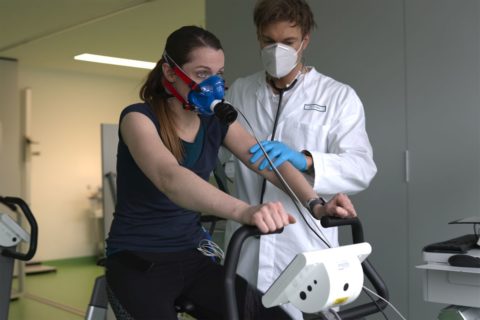Healthier thanks to innovative 14 minute “LOW-HIIT” workouts

LOW-HIIT concept of the Erlangen Hector Center has been proven to help several health conditions.
Regular exercise is an important component of a healthy lifestyle. “Physical exercise does not only have many preventative health benefits, it also has a significant role to play as a supporting measure in treatment for a number of chronic illnesses,” explains PD Dr. Dejan Reljic, Head of Sport Science and Performance Physiology at the Hector Center for Nutrition, Exercise and Sports at Department of Medicine 1– Gastroenterology, Pneumology and Endocrinology at Universitätsklinikum Erlangen. And yet most people fail to get enough exercise nowadays, often because of time constraints. Dr. Reljic explains, “bearing this in mind, we have developed an extremely time-efficient training concept, known as low-volume high-intensity interval training, or LOW-HIIT for short.” Researchers at the Hector Center in Erlangen have now proven in three studies that short bursts of exercise lasting just 14 minutes in total has a positive effect on various conditions such as chronic illnesses, obesity or a fatty liver. In future, they intend to investigate whether or to what extent the effects proven in the study may be boosted even further by introducing tailored nutrition strategies.
“The minimum amount of physical activity recommended by the World Health Organization of 150 minutes per week definitely makes sense and is worth trying to achieve, but not many people manage nowadays. That apart, people with physical limitations are often not able to exercise actively for very long,” explains Dr. Reljic. “In recent years, we have been working intensively on training programs that are considerably more time-saving but still have health and/or therapeutic benefits.” LOW-HIIT has proven to be particularly effective.
Just 14 minutes twice a week: LOW-HIIT
“With our LOW-HIIT program, participants just complete five one-minute intervals at an individually determined target pulse rate. All together, one LOW-HIIT unit including warming up, recovery phases between the intervals and cooling down only lasts 14 minutes. The total time devoted to training is only 28 minutes a week, less than one fifth of the general WHO recommendation,” explains Dr. Reljic.
Beneficial for liver health
In the first of the three recently published studies, researchers at the Hector Center were able to prove that a twelve week LOW-HIIT exercise regime not only considerably improved the cardiovascular performance and various cardiometabolic risk markers such as blood pressure in obese patients with metabolic syndrome, but also had a positive effect on liver health. “Many of those suffering from obesity and metabolic syndrome also have what is known as non-alcoholic fatty liver disease (NAFLD), where fatty tissue accumulates in the liver. Over time, NAFLD can develop into a chronic inflammation of the liver or even cirrhosis,” according to Prof. Dr. Yurdagül Zopf, director of the Hector Center. Dr. Reljic adds, “that is one of the reasons why we are so pleased that we were able to make a significant difference to participants’ health after just a few weeks using this extremely time-saving training method.”
LOW-HIIT reduces inflammation markers
In the second study, the researchers investigated the impact of various time-efficient training concepts on chronic inflammation parameters in obese people with metabolic syndrome. As well as LOW-HIIT, these included single-set weight training in which people train with just a single set of repetitions instead of several sets, and full-body EMS training. During electrical muscle stimulation (EMS), the muscles are specifically targeted with electric impulses using a full-body vest and special pads. The stimulation is meant to make muscles grow faster. “A considerably higher than normal proportion of fat cells in tissue usually correlates to an increased release of inflammation mediators in the body. Chronic low-grade systemic inflammation such as this is linked to numerous health problems and can lead to cardiovascular diseases or cancer over time,” explains Prof. Zopf. “Our study has shown that compared to other time-efficient training methods, LOW-HIIT is the most effective when it comes to reducing inflammation markers in the body,” reports Dr. Reljic. “We were particularly surprised to discover that following a LOW-HIIT regime over several weeks can have anti-inflammatory effects similar to those obtained by taking medication,” Dejan Reljic continues.
Also suitable for cancer patients
The third study proved that LOW-HIIT is also a safe and feasible method of training for patients with advanced cancer. “This vulnerable group typically suffers from a weakened immune system,” explains Dr. Hans Joachim Herrmann, head of Nutrition at the Hector Center. “Until now, there was a certain degree of hesitancy about encouraging this group of patients to participate in intense physical training for fear of weakening the immune system even further,” added Dr. Reljic. “Our results indicate that the opposite appears to be the fact, however. In collaboration with Prof. Dr. Dimitrios Mougiakakos from Universitätsklinikum Magdeburg and Dr. Benedikt Jacobs from Department of Medicine 5 – Hematology and Oncology at Universitätsklinikum Erlangen, who both conduct research into tumor biology, we were able to ascertain that one LOW-HIIT unit leads to increased activation of the body’s own natural defenses. These “killer cells” have a crucial role in eliminating cells that have become infected with viruses or malignant tumor cells.” At the same time, after twelve weeks of LOW-HIIT training, participants’ physical fitness improved, their cardiovascular performance increased, they were less exhausted and felt physically better.
Links to original publications:
Study 1: https://pubmed.ncbi.nlm.nih.gov/35485357/
Study 2: https://pubmed.ncbi.nlm.nih.gov/35631137/
Study 3: https://pubmed.ncbi.nlm.nih.gov/35868017/
Further information:
PD Dr. Dr. Dejan Reljic
Phone: +49 9131 85 45220